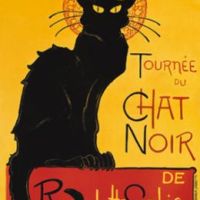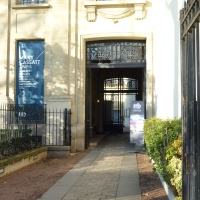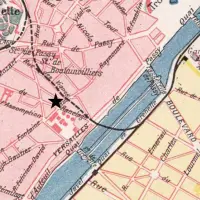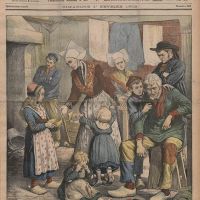I don’t remember where I bought the postcard, although the price on the back shows that I lashed out a whopping 5 euros on it. It shows an undistinguished shopfront covered in advertising. It must have been the caption that caught my eye: “33 rue Vauvilliers, Anciennement Hotel de Cherbourg, habité en 1787 par Napoleon Bonaparte.”
When the photograph was taken in the early 1900s, the former Hotel de Cherbourg was an agency owned by one Emile Degroiseilliez who bought and sold butcher’s shops or their equipment (if I am translating the signs correctly).
To the left, at No. 31, is an establishment owned by someone called Métifeux, who appears in a 1907 business directory as a wine merchant at that address. The business on the right is harder to make out, but the same directory tells me that No. 35 was occupied by someone called Sutter, who sold specialized attire for people working in kitchens or other parts of the food business.
Today, the rue Vauvilliers extends for one block only, between the rue St-Honoré and the rue Berger, which skirts the south side of the huge development of Les Halles. No. 33 is nowhere to be seen. The numbers go up only as far as 11 on the odd-numbered side of the road.
But the rue Vauvilliers (in Napoleon’s day it was called the rue du Four St-Honoré) once continued north all the way to the space in front of St-Eustache. In the late 19th century, and at the time the photograph was taken for the postcard, the huge market buildings of Les Halles took up the eastern side of the street.
So my fingers did the walking to the wonderful website of the archives of Paris to look at their detailed maps.
The archives provide maps for before and after 1860, when the city’s geography changed. Here is the older version. I love the way it shows the interior layout of the buildings. No. 33 is about halfway up on the right side of the block.
The archives also providea a map from later in 19th century showing that when the postcard was made, No. 33 faced the market buildings in Les Halles where meat and fowl were sold (so the enterprise for buying and selling butcher’s shops makes sense).
This is what it looked like in 1866, in a photograph taken from the intersection with the rue de Vannes (another street that has disappeared) by Charles Marville, long after Napoleon’s day.
The map from the archives shows how this oddly shaped block was designed to complement the circular market building to the west, the Halle aux Blés, later known as the Bourse de Commerce, now an art exhibition space. That was certainly there in Napoleon’s day, as shown in a 1785 drawing by Jean-Baptiste Maréchal.

It also appears on a 1788 map by L.F. Deharme.

So what was Napoleon, aged about 18, doing hanging about in Paris in September 1787? He had, of course, spent time in Paris at the Ecole Militaire when he was in his mid teens, but at this point, he was on leave from the military, and was in the capital on family business. He occupied room No. 9 on the third floor at the hotel Cherbourg.
Apparently it was all about mulberry trees. Bear with me. Mulberry trees are used to raise silkworms. Napoleon’s family had started a plantation of mulberry trees, with funding from the government, hoping to develop the silk industry in Corsica. Mulberry trees take a while to mature, and before the plantation was fully grown, the government cut off the funding. Napoleon’s job was to get the funding restored.
He was not successful. It’s a wonder that anyone thought that this teenager without connections would make any headway on a project in which the bankrupt government of Louis XVI had long since lost interest. Otherwise, he spent time trying to write historical fiction. That wasn’t successful either. He didn’t stay long at the Hotel de Cherbourg.
Napoleon had many addresses in Paris over the years, but one other establishment is connected with his teenaged years: No. 5, quai de Conti, where he spent time in 1785. This image dates from 1827, when the building contained the offices of the Encyclopédie Méthodique.
Here is where it fits on the map from 1788. It was on the corner between the rue de Nevers and the rue Dauphine, facing the Pont Neuf.

Napoleon didn’t live there. It belonged to a family called the Permons (or Permonds), Corsican friends of the Bonapartes, who invited him to stay from time to time while he was studying at the Ecole Militaire. One of the daughters of the family, who later married the Duc d’Abrantes, wrote down her memories of Napoleon:
My father, who was acquainted with almost all the heads of the military school, obtained leave for him sometimes to come out for recreation. On account of an accident—a sprain, if I recollect right—Napoleon once spent a whole week at our house. To this day, whenever I pass the Quai Conti, I cannot help looking up at a garret window at the left angle of the house, on the third floor. That was Napoleon’s chamber when he paid us a visit, and a neat little room it was. (p. 23)
That house is gone now, too, replaced by a group of buildings from the 1920s known as the Carrefour Curie, which makes an architectural nod to the 18th century, with an unusual arched entryway to the adjoining rue de Nevers right through the middle of the building.

However, the old quai de Conti house would have stood long enough for Napoleon to have seen it in later days, if he ever looked across the river from the Louvre. But I doubt that he was sentimental about old buildings.
Text by Philippa Campsie, image of No. 33, quai Conti from Musee d’Art d’Histoire; image of Carrefour Curie from Paris La Douce; all other images from Gallica and our postcard collection; maps from Wikimedia and the Paris Archives.


























My husband and I enjoy your posts so much. I often jot down notes for our next trip to Paris. This time it’s Bourse de Commerce, the art exhibition space that you mentioned. Thank you so much for your work.
I have seen some photos in a magazine and it looks like an amazing space. It’s on our list too!
Fabulous recounting, Philippa, with very satisfying visuals, as always. Most of us do retain a certain nostalgia for those buildings we have lived in, even briefly, in our lives, though Napoleon’s tastes certainly ran more to palaces rather than boarding houses. You may know that he is also said to have lived at 10, rue de la Huchette in 1795. One wonders if tourists were being waved into tiny restaurants along that street even then! https://www.napoleon.org/histoire-des-2-empires/articles/une-chronique-de-chantal-prevot-rue-de-la-huchette-les-ombres-de-lhistoire/
Thank you so much for that link. Interesting, particularly about the “rebus” sign “Y”. All the best!
Do you know if the Hôtel de Cherbourg was named such when Napoleon stayed there? If so it is quite a coincidence as he later, as Premier consul Bonaparte, is credited with the construction of the military port in the city of Cherbourg. It is still the longest artificial harbor in the world. Napoleon would be pleased. There is a monumental equestrian sculpture of him there. The municipality even planned to rename the town as Napoléon Bourg but it never happened.
https://www.napoleon.org/histoire-des-2-empires/articles/cherbourg-une-ville-napoleonienne/
Thanks for you always interesting articles.